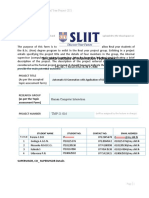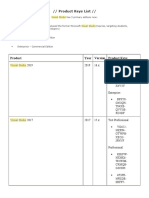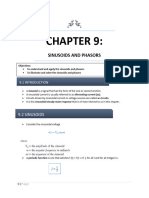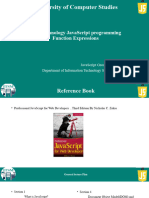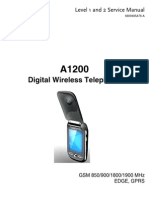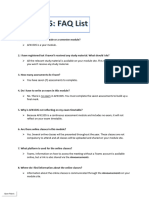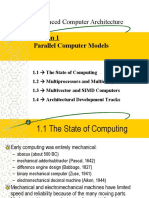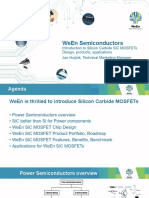0 ratings0% found this document useful (0 votes)
107 views10 pagesUnit - 3,4,5 Q. & Ans
Uploaded by
Pratima PandayCopyright
© © All Rights Reserved
We take content rights seriously. If you suspect this is your content, claim it here.
Available Formats
Download as PDF, TXT or read online on Scribd
0 ratings0% found this document useful (0 votes)
107 views10 pagesUnit - 3,4,5 Q. & Ans
Uploaded by
Pratima PandayCopyright
© © All Rights Reserved
We take content rights seriously. If you suspect this is your content, claim it here.
Available Formats
Download as PDF, TXT or read online on Scribd
You are on page 1/ 10
Part – A Employability Skills
Class 9 Important Questions and Answers
Unit – 3 Information and communication technology Skills
Session 1: Introduction to ICT
1. Objectives of Information and communication technology? Advantages and
disadvantages of ICT.
Answer – Full form of ICT is Information and communication technology. The goal of ICT is to
bridge the gap between parents, educators, and students by encouraging sustainable,
cooperative, and transparent communication methods.
Advantages of ICT
Enhanced the modes of communication
Independent learning platforms Cost – efficient
Enhanced data and information security
Paperless – Eliminate the usage of paper
Better teaching and learning methods
Web – based LMS tools
Disadvantages of ICT
Traditional book and handwritten methods are at risk.
Managing courses online is difficult
Teachers require experience to handle ICT
Risk of cyber attacks and hacks
Misuse of technology
Session 2: ICT Tools: Smart phones and Tablets – I
2. What is the default apps installed on Smartphone’s?
Answer – Some of the default apps installed on Smartphone‟s are
Camera
Phone
Calendar
Maps
Clock
Message
Web Browser
Music
Google Play store
Apple Store
3. Differentiate between Smartphone vs. tablet.
Answer – Smart phone – Smartphone are just like a phone with some additional features,
Smart phones are compact and easy to use. Operating systems are the main software. Some of
the smart phones use Apple iOS, some are using Android OS or some are using Microsoft OS.
Editing the videos or photos is difficult on the Smartphone.
Tablet – It is a portable personal computer with a touch screen interface which makes it more
user friendly than the notebook computer. Android OS, Apple iOS or Windows OS are the most
common operating systems used in the tablet. As compared to smart phones, tablet screens are
bigger in size.
Session 3: ICT Tools: Smart phones and Tablets – II
4. What are the features of mobile devices?
Answer – Some of the features present in mobile devices are
a. Bluetooth: Bluetooth is a wireless technology which connects with other Bluetooth devices
within 30 feet; you can send photos, songs or video with the help of the Bluetooth.
b. Chargeable Battery: This is a portable power bank which can be recharged. if once the
battery is charged you can use this device anywhere.
c. Wi-Fi: Wi-Fi stands for Wireless Fidelity, basically it is a wireless network technology that
connects your device to the internet or you can connect to the local area network also.
d. Touch Screen: Touch Screen is an interface where you can manage your device. Whatever
information you want to type in the device you can type using the touch screen.
e. Cellular network connectivity: Cellular network connectivity provides the network through
which you can make calls.
f. Global Positioning System: It is a navigation system which helps you to find the direction of
place using a map.
5. What is the purpose of gestures in mobile devices?
Answer – Gestures help users to interact with the touch screen. For example if you want to
open an app instead of clicking you just touch the app the application will be open.
Some of the gestures in mobile phone are
a. Tap and hold: Tap and hold is similar to right-clicking on a computer.
b. Swipe: Swipe the finger to right, left, up or down on the screen, automatically the page will
move to the next page.
c. Tap: Touch the screen with your finger, once, to click.
d. Double tap: Tap the screen twice time quickly the screen will zoom; it is used to making the
word appear bigger.
e. Drag: To tap, hold and move your finger across the screen.
f. Pinch: To bring your thumb and finger together on the screen automatically the screen will be
zoomed in. it is used to making the word appear smaller.
Session 4: Parts of a Computer and Peripherals
6. What is the basic function of a Computer?
Answer – A computer is an electronic device which can accept data from the user, process the
data and generate meaningful results. Computers have three main units –
1. Input Unit,
2. Central Processing Unit (CPU) and
3. Output Unit.
7. What are the different parts of the CPU?
Answer – A computer is made up of multiple parts that work together to perform the processing
and effective functioning of the computer.
The CPU performs all the basic arithmetic and logical operations of the computer.
There are three main components of a CPU (Central Processing Unit)
1. Arithmetic and Logic Unit (ALU)
2. Control Unit (CU)
3. Memory Unit (MU)
a. Arithmetic and Logic Unit (ALU) – Arithmetic and logical unit performs all arithmetic and
logical operations. for example subtraction, addition, division and multiplication.
b. Control Unit (CU) – Control Unit instructs the computer system to perform a particular task. It
takes instructions from memory and executes them.
c. Memory Unit (MU) – Memory Unit used to store data or instructions. There are two type of
memory unit
i. Primary Memory – Primary memory is also known as main memory. This memory is directly
accessed by the microprocessor. Primary memory has two types RAM and ROM
i) RAM – RAM stands for Random access memory it is short term memory, RAM is also
known as Volatile memory and it stores data temporarily.
ii) ROM – ROM stands for Read only memory it is long term memory, ROM stores the
data permanently.
ii. Secondary Memory – The device which is used to store data permanently with the help of
external devices is known as Secondary memory. Example – Hard Disk, Flash drive, External
drive etc.
8. What is Motherboard?
Answer – A motherboard provides connectivity between the hardware components of a
computer. It is also the backbone of the computer and shares the information between them. It
is a main circuit board inside a computer that connects input, processing and output devices.
9. How is the data measured in the computer?
Answer – In the memory devices data is stored in the form of bits and bytes. Bit is the smallest
unit which represents 0 or 1. Combinations of eight bits make a one byte. which store the
numerical, letters or symbols value in the memory.
8 Bits = 01 Byte
1024 Bytes = 01 Kilobyte (KB)
1024 Kilobyte (KB) = 01 Megabyte (MB)
1024 Megabyte (MB) = 01 Gigabyte (GB)
1024 Gigabyte (GB) = 01 Terabyte (TB)
10. Where are the different ports in the computer system?
Answer – A port is a physical docking point using which an external device can be connected to
the computer. We can connect our keyboard, mouse, printer and scanner through the port.
There are several types of ports that you can use to connect a computer to external devices.
a. Universal serial bus or the USB port – USB port is used to transfer data, It also works as
an interface for peripheral devices. It connects, such as a mouse or a keyboard or a printer to a
computer using the cable.
b. Display port – Separate video connector is used for transmitting only video signals. Display
port connect the monitor to the display unit. Different types of video connector are available, like
High Definition Multimedia Interface (HDMI) and Video Graphics Array depending on the
requirement.
c. Audio ports – Audio ports are used to connect speakers or other audio devices with the
computer. like headphones, speakers or microphone. headphones and speaker port is known
as line out port and microphone port is known as line in port.
d. Ethernet – Ethernet port is used for connecting computers to the network, with the ethernet
port we can transfer data from one computer to another or we can transfer high speed internet.
e. Power port – Power port is used for connecting the computer system to the power supply.
Session 5: Basic Computer Operations
11. Difference between Hardware and Software?
Answer – A computer system consists of two main parts – the hardware and the software.
a. Hardware – The physical parts of the computer are hardware, hardware devices can be
touch and feel. for example Mouse, Keyboard, Monitor, CPU, etc.
b. Software – Software is made by programs; it is a set of instructions used to execute specific
tasks. for example Microsoft Office, Operating System, Photo editing software.
12. In computer systems, what is the function of the BIOS?
Answer – BIOS stands for Basic Input/ Output System, Computer automatically runs a basic
program called BIOS as soon as it is switched on or the power button is pushed on.
The BIOS first does a self-test. If the self-test shows that the computer is fine, the BIOS will load
the Operating System.
13. What are the different types of keys in Keyboard?
Answer –
a. Function keys – F1 to F12 are function keys in the keyboard, function keys are used for
specific purposes.
b. Control keys – SHIFT, CONTROL (CTRL), ALT, SPACEBAR, TAB AND CAPS LOCK are
known as a control key, these keys are used as per the demand.
c. Enter key – ENTER or RETURN keys are known as Enter key, depending on the brand of
computer that you are using.
d. Punctuation keys – It includes keys for punctuation marks, such as colon (:), semicolon (;),
question mark (?), single quotation marks („ ‟), and double quotation marks (“ ”).
e. Navigation keys – END, HOME, PAGE DOWN, PAGE UP and Arrow keys are known as
navigation keys, these keys are used to move up, down, left or right in the document.
f. Command keys – BACKSPACE, INSERT (INS) and DELETE(DEL) are known as command
keys. INSERT key allows you to overwrite characters to the right side. The DELETE command
key and BACKSPACE key are used to remove typed text, character, or any other objects from
the right and left side of the cursor.
g. Windows key – Windows key is used to open the Start menu.
Session 6: Performing Basic File Operations
14. What are files and folders in a computer system?
Answer –
a. File – File is a collection of information different types of files store different types of
information. Every file has a file name and extension that identifies the type of file.
b. Folder – Folder is a collection of files or a group of files.
Session 7: Communication and Networking – Basic of Internet
15. What is Bandwidth?
Answer – Bandwidth is the amount of data that can be transferred or received every second.
and it is measured by bps (Bite per second).
For example, in the water pipe the amount of water transmitted in a certain time is known as
bandwidth. The maximum amount of water that can flow through the pipe is maximum
bandwidth. Similarly, the amount of data that can be sent or received in the network depends on
the bandwidth.
Bits per second are the unit of measurement for bandwidth (bps) in computer networks and in
analog devices it is measured as a cycle per second.
Data transfer speed measured by the bits per second.
1 Kbps (kilo bits per second) = 1,000 bits per second
1 Mbps (megabits per second) = 1,000 kilobits per second
1 Gbps (gigabits per second) = 1,000 megabits per second
Session 8: Communication and Networking – Internet Browsing
16. What is the World Wide Web?
Answer – WWW stands for World Wide Web, it is also known as a Web. Web is a collection of
websites and a website is a collection of web pages. All websites and web pages are stored in
the web server. The Web is a vast network interlinked with each other.
It is made up of
A web page
A web browser
A system to transfer information between the web browser and the web pages
Session 9: Communication and Networking Introduction to Email
17. What is email?
Answer – An electronic communication invented in the 1970s to do communication faster, Email
is fast and easy to use and it can be sent to multiple people at the same time, Email containing
videos, documents, spreadsheets etc. can be sent along with the email as attachments.
Session 10: Communication and Networking – creating an email
account
18. Differentiate type of email provider?
Answer – If you want to create an email account, you can follow any one of the provider
Gmail (run by Google)
Yahoo mail (run by Yahoo)
Outlook mail (run by Microsoft)
Session 11: Communication and Networking – Writing an email
19. Differentiate between CC & BCC?
Answer –
a. CC – When you want the email list to be visible to all recipients, and you want to include all
the recipients.
b. BCC – When you want to include additional recipients but don‟t want the recipient to know
who else is receiving the email.
20. What are the different types of folders in email?
Answer – There are different folders that could help you manage and organize your emails.
a. Inbox – By default email is received in the inbox.
b. Send – Send folder store emails that you have sent to other peoples.
c. Drafts – When you are writing an email and you have not sent the email to any other user,
that time email will be stored in draft by default.
d. Trash – Trash holds deleted email from the inbox. To delete an email, you select an email
and then click on the Delete button for it to be moved from inbox to trash folder
Session 12: Communication and Networking – Receiving and
Replying to email.
21. In email, what is the difference between respond and forward?
Answer –
a. Reply – Replying to an email means that you are answering the mail you have got.
b. Forward – Forwarding an email is sending the mail to someone else the way you have got.
Unit -4 Entrepreneurial Skills
Session 1: Entrepreneurship
1. What is Entrepreneurship?
Answer – An entrepreneur is a person who creates a new business, takes risks, brings new
ideas to start a business and is self employed.
2. What are the different ideas entrepreneurs add?
Answer – New ideas with which an entrepreneur adds varieties of product, new services, cost
reduction ideas, or new marketing techniques.
Session 2: Role of Entrepreneur
3. What are the roles and benefits of entrepreneurs?
Answer – The role and benefits of entrepreneurship
a. Economic Development – As entrepreneurs provide quality products and services for the
customer, entrepreneurs grow their business, invest the money in the business and expect good
returns.
b. Social Development – In the beginning the business is usually very small, to become
successful in the business entrepreneur have to expand their business, to expand the business
entrepreneur have to work hard and they have to create more jobs. When the jobs are created
by the entrepreneur then more people will earn money and have a good life.
c. Improved Standard of Living – When entrepreneurs sell quality products to the customer,
quality products help people live a more comfortable life.
d. Optimal Use of Resources – Around us a lot of renewable and no-renewable resources are
available. Entrepreneurs have to find the most optimal ways of using the resources to reduce
costs and increase their profits.
Session 3: Qualities of a Successful Entrepreneur
4. What are the qualities of successful entrepreneurs?
Answer – An entrepreneur needs to have the following qualities –
a. Patience – Success may not be achieved in one-day, it can take time. It is important for an
entrepreneur to be patient.
b. Positivity – Always be positive when you are finding difficulty in the business. An
entrepreneur has to think positively even when he/she takes a big risk.
c. Hard working – An entrepreneur has to work hard till it becomes successful in the business.
d. Confidence – An entrepreneur has to make decisions and be very confident about their
business. An entrepreneur needs to communicate with the customers confidently.
e. Open to Trial and Error – Entrepreneurs have to implement new ideas, implement trial and
error and new experiments without fear of failure to tell the business becomes successful.
f. Creativity and Innovation – An entrepreneur should be able to see and identify the problem
from different perspectives and come up with creative solutions.
Session 4: Distinguishing Characteristics of entrepreneurs and wage
employment
5. Characteristics of Entrepreneurs?
Answer – Adaptable and flexible to achieve the goals of enhancing quality and customer
satisfaction
1. Believe in hard work
2. Ability to take up risks
3. Money Management
4. Knowledge of the product and services and their need or demand in the market
5. Effective planning and execution
6. Financial literacy
6. What is wage employment?
Answer – Wage management is based on work grades and performance parameters. Wage
management‟s goal is to take reward and give high performance standards in the business.
The wage management does not take too much risk but entrepreneurs have to take risks.
7. Benefits of entrepreneurship?
Answer – The various benefits of entrepreneurship are –
1. Work for yourself, and not for others
2. More risk, more profit
3. Do what you are interested in
4. Make profits for yourself
Session 5: Type of Business Activities
8. What are the different types of business activities in entrepreneurship?
Answer – There are three types of business activities in entrepreneurship
a. Product business – If entrepreneurs sell any physical product to the customer which can be
seen and touched is called a product business. Example grocery item, sport item or electronic
item.
b. Service business – If an entrepreneur provides some services to the customers it is called
service business. example – caching institute, electronic services shops, call centers etc.
c. Hybrid business – Combination of product and service business is called hybrid business.
example – Mobile shop, they provide sell and service both.
Session 6: Product, Service and Hybrid Businesses
9. Difference between product business and service business?
Answer –
a. Product Business -If entrepreneurs sell any physical product to the customer which can be
seen and touched is called a product business. Example grocery item, sport item or electronic
item.
b. Service Business – If an entrepreneur provides some services to the customers it is called
service business. Example – caching institute, electronic services shops, call centers etc.
10. Types of product – based business?
Answer – There are two types of product – based businesses
a. Manufacturing Businesses – There are a lot of different types of factories which
manufacture different types of products.
b. Trade Business – That type of business which buys and sells products to customers. In the
trade business transport the product from the factory to warehouses and then to the shops.
example – retail shops, distributors and wholesalers.
Session 7: Entrepreneurship Development Process
11. What is the entrepreneurship development process?
Answer – To enhance the knowledge and skills through several training programs whether it is
formal or informal, the entrepreneur development process helps to achieve the goals.
There are different types of steps for starting a business
1. Idea
2. Getting money and material
3. Understanding customer needs
4. Improving Product/ service
Unit – 5 Green Skills
Session 1: Society and Environment
1. What are the different natural resources available?
Answer – Natural resources can be solid, liquid or gas. These resources can be organic,
inorganic, metallic or non-metallic.
a. Land Resources – Agricultural, infrastructure development and residential land comes in
land resources.
b. Forest Resources – Forest is important to human beings, some of the resources of forest
are timber resources, honey, horns, waxes and insecticides.
c. Water resources – Water covers about 75% of earth surface and is necessary for life. Water
resources like – Rivers, oceans, lakes, and underground water.
d. Mineral Resources – Mineral reserves are reducing every year through mining activities. We
have to reserve natural resources like petroleum, gas, copper, aluminum, water etc. Naturally
mineral resources are in three categories: solid, liquid or gas.
e. Food Resources – Plants serve food for many organisms. Resources that are used to make
food are called food resources. Agriculture is the main source of food resources.
f. Energy Resources – Heat, Power life or producing electricity is an energy resource. There
are four fundamental sources of energy.
Solar Energy
Gravity
Nuclear energy
Energy in the interior of the Earth
2. What are the different natural resources?
Answer – Different types of natural resources are
a. Inexhaustible Resources – Inexhaustible resources cannot be finished by humans for
example sun energy, wind power and water.
b. Exhaustible Resources – Exhaustible resources are those resources which are present in
limited quantities. for example copper, coal, gold etc.
c. Renewable Resources – Renewable resources are constantly available and can be
replenished. for example water, sunlight, wind etc.
d. Non-renewable Resources – That type of resource which is not replaced easily. Examples
minerals, fuels
3. How do human activities damage the earth and environment?
Answer – Let see some of the human activity damaging the earth and environment-
a. Over Exploitation – Our earth and environment exploitation has been increasing during
recent years. Now we are exploiting species, wood, and minerals more than natural production.
This affects directly or indirectly to the earth and environment. Example deforestation,
Overfishing, removal of trees and wild medicinal plants and over hunting.
b. Mining – The extraction of rich minerals from the ground is known as mining. Mining has an
impact on the soil and the ecosystem. Metals, minerals, and diamonds are some of the precious
minerals mined from the earth.
c. Deforestation – Damaging the forest or cutting down trees is known as deforestation.
Deforestation also affects the environment. For example, cutting down trees for agriculture,
construction of houses.
d. Pollution – Pollution derived from the Latin word “polluere” meaning “to soil”. Pollution is the
process of making water, land and air dirty and not safe or suitable to use.
Pollution affects plants, animals and humans, pollution increases due to human activity.
4. What is climate change?
Answer – Climate change means change in the environmental condition of the earth. Human
activities are the largest contribution of climate change and earth temperature by burning fossil
fuels, Increasing livestock farming, Fertilizers containing nitrogen and cutting down trees.
5. How does harmful radiation affect climate change?
Answer – Ozone layer protects earth from harmful radiation from the sun, Ozone layer is made
of a gas. Coolants in refrigerators, Air – conditioners and Cleaning chemicals directly affect the
Ozone layer.
When ozone layer affects the harmful radiation comes to earth and increases health disorders.
6. What are natural disasters?
Answer – Natural disasters depend on climate change, when the climate change earthquakes,
floods, storms, landslides etc. affect the earth.
To save the earth and environment we need to educate people about the environment, through
the environment and for the environment.
7. How to save the environment?
Answer – There are three things people need to do to save the environment.
a. Reduce – If you manage waste management properly, if you reduce the use of unnecessary
products or items, buy items with minimal packaging, avoid buying plastic bags or plastic
products etc.
b. Reuse – Always try to reuse waste products in a different way or reprocessing. For example,
making pillow covers you can use old shirts or old ladies suits.
c. Recycling – Reusing some components of the waste that may have some economic value.
Paper, Metal, glass and plastics are recyclable. You can recycle the plastic, metal, glass, and
paper products.
Session 2: Conserving Natural Resources
8. What is soil conservation?
Answer – Soil conservation means improving the soil fertility by adopting various methods.
1. Maintain the soil using natural fertilizers, adding manure and liquid fertilizer make the soil fertility
healthy.
2. Grazing should be allowed only on the specified areas.
3. Reforestation on the open space which can reduce soil erosion.
4. Dividing the slope into several flat areas to control the rapid run of water.
9. What is water conservation?
Answer – Water is essential for everyone, we have to conserve water. This will happen only
when we adopt the following methods.
Reforestation will help to hold water in the soil and help to formation of groundwater.
Rainwater harvesting should be used for storing rain water and recharging groundwater.
Dams and reservoirs can be used to supply water to the fields.
Sewage and Industrial wastes should be treated properly.
10. What is energy conservation?
Answer – Conservation of energy means saving the energy and using it efficiently. We use a lot
of non-renewable energy resources for our needs. we have to save them –
1. Use LED bulbs instead of using Tube light or normal bulbs.
2. Switch of fans, TV, lights and other electrical appliances when it is not used.
3. Using a pressure cooker to make food will save energy.
4. Keep the bulb and tubes clean.
Session 3: Sustainable Development and Green Economy
11. What is sustainable development and what are the goals?
Answer – Sustainable development is the development which doesn‟t compromise the capacity
of the future generation to satisfy their needs.
In 1987 the first time sustainable development appeared in the Brundtland report. This was a
warning to all countries regarding environmental consequences, globalization and economic
growth.
Sustainable Development goals are also known as Global goals. There are 17 goals in
sustainable development which were introduced in 2015.
There are total 17 Sustainable Development Goals are: :
1. Zero Hunger
2. No Poverty
3. Good Health and Well-Being
4. Quality Education
5. Climate action
6. Industry Innovation and Infrastructure
7. Gender Equality
8. Clean Water and Sanitation
9. Affordable and clean energy
10. Sustainable cities and communities
11. Decent work and economic growth
12. Reduce Inequalities
13. Responsible consumption and production
14. Life on land
15. Life below water
16. Partnerships for the goals
17. Peace, Justice and strong institutions
12. What is Green growth?
Answer – Green growth is an approach for achieving economic growth that is socially inclusive
and environmentally sustainable.
The Indian Government included Green growth in its vision, where „poverty eradication‟ and
green growth is the focus point of the green economy.
13. What is a green economy?
Answer – In 1989 The Government of the United Kingdom introduced the „Green Economy‟. As
per the UNEP definition the green economy one that results in reducing environmental risks,
ecological scarcities, improved human well-being, ecological scarcities, and social equity.
14. What are the components of a Green Economy?
Answer – The Green Economy includes the following components.
Renewable Energy
Green Building
Waste Management
Water Management
Land Management
Well – Managed transportation
15. What do you mean by Green Skills?
Answer – The skills required for promoting the Green Economy are known as green skills for
example sewer water treatment, renewable energy, climate resilient cities, green construction,
or solid waste management etc.
16. What are Green Jobs?
Answer – Many companies create jobs to decrease environmental issues due to factories or
waste management.
This company required a person to preserve or restore the environment in the natural way that
is Green Jobs.
17. What are the Green Projects?
Answer – To save the environment, many organizations are taking initiatives. They are
implementing Waste management, Energy conservation, Bio fuel use, Green sanitation, Green
Building etc.
You might also like
- Basic ICT Skills Class 9 Questions and AnswersNo ratings yetBasic ICT Skills Class 9 Questions and Answers7 pages
- 9 Q & A - Ict Skills & Enterpreneurship SkillsNo ratings yet9 Q & A - Ict Skills & Enterpreneurship Skills39 pages
- Basic ICT Skills Class 9 Questions and AnswersNo ratings yetBasic ICT Skills Class 9 Questions and Answers9 pages
- Unit-3 Information and Communication Technology Skills-1No ratings yetUnit-3 Information and Communication Technology Skills-16 pages
- Places Where ICT Is Used: ICT at Workplace - ICT at Home - ICT at Agriculture - ICT at Banking and FinanceNo ratings yetPlaces Where ICT Is Used: ICT at Workplace - ICT at Home - ICT at Agriculture - ICT at Banking and Finance8 pages
- Class: X: Subject: Information TechnologyNo ratings yetClass: X: Subject: Information Technology36 pages
- AUTONOMOUS B.Tech EEE R20 Course StructureNo ratings yetAUTONOMOUS B.Tech EEE R20 Course Structure8 pages
- Patch and Settings Management in Microsoft System Center Configuration Manager 2012No ratings yetPatch and Settings Management in Microsoft System Center Configuration Manager 201236 pages
- Deploying The Best Model in A Few Minutes With Bentoml and MlflowNo ratings yetDeploying The Best Model in A Few Minutes With Bentoml and Mlflow11 pages
- History of Data Storage & How Computers Store Datas and InformationsNo ratings yetHistory of Data Storage & How Computers Store Datas and Informations17 pages
- Manual de Reparacion Nivel 1 y 2, Motorola A1200No ratings yetManual de Reparacion Nivel 1 y 2, Motorola A120054 pages
- Voltage Stability of Electric Power Systems: Printed BookNo ratings yetVoltage Stability of Electric Power Systems: Printed Book1 page
- Advanced Computer Architecture: Section 1 Parallel Computer ModelsNo ratings yetAdvanced Computer Architecture: Section 1 Parallel Computer Models56 pages
- Klockner Moeller EASY 512 Programming InstructionsNo ratings yetKlockner Moeller EASY 512 Programming Instructions10 pages
- CS4122 Triple Air-Core Gauge Driver With Serial Input Bus: SO-24L DWF Suffix CASE 751ENo ratings yetCS4122 Triple Air-Core Gauge Driver With Serial Input Bus: SO-24L DWF Suffix CASE 751E12 pages
- We en Web in Ar Sic Mosfet 1638931895460No ratings yetWe en Web in Ar Sic Mosfet 163893189546029 pages
- WMS-SCAFFOLDING PROCEDURE ETI HVAC Rev.00B100% (1)WMS-SCAFFOLDING PROCEDURE ETI HVAC Rev.00B31 pages
- Hu Vehicle Management System Project EditedNo ratings yetHu Vehicle Management System Project Edited27 pages




















































